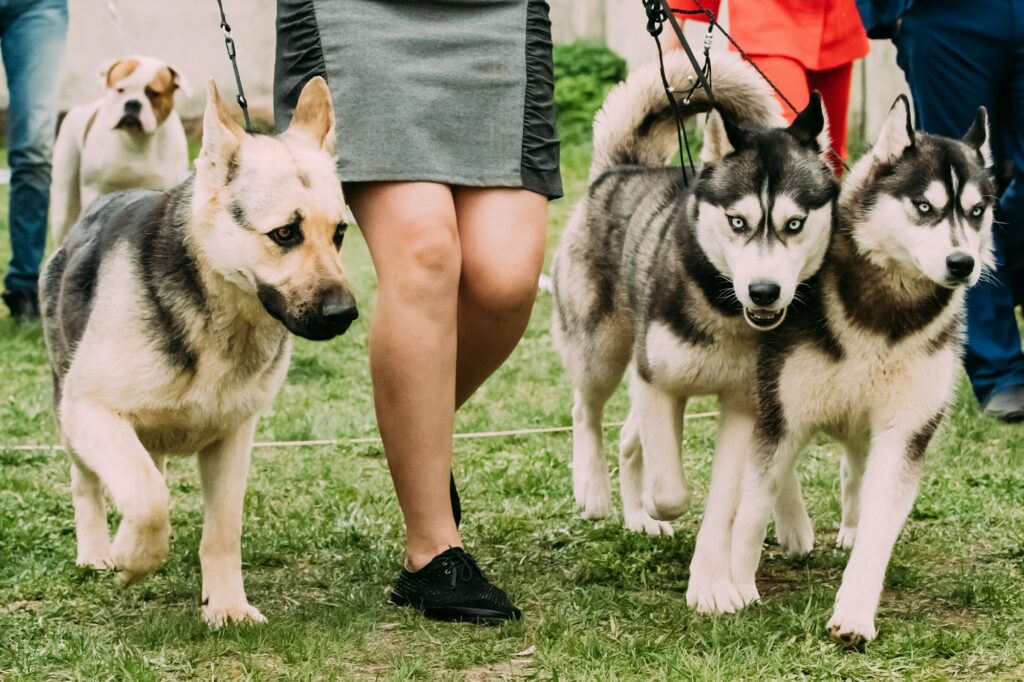Training your furry friend can be a rewarding yet challenging endeavor. It’s crucial to understand that every dog is unique, with its own strengths, weaknesses, and quirks. What may prove successful for one dog might not necessarily yield the same results for another. This comprehensive blog explores the various types of dog training methods available. We will explore these different techniques and provide insight to help you discern which type of training is the most effective and suitable for your beloved canine companion. Our goal is to help you make an informed decision that will ultimately benefit you and your dog in your training journey.
It is important to note that various factors come into play regarding dog training. For instance, the breed of the dog could influence its predisposition to certain behaviors. Additionally, the dog’s age can also be a determining factor since puppies often require different training approaches compared to older dogs. And the dog’s temperament is yet another important aspect to consider, as it can significantly affect its responsiveness to different training techniques. But don’t worry, we will cover all these things in this blog.
Types of Dog Training
Let’s take a closer look at the diverse types of dog training methods. Each type is unique and specifically designed to address certain behaviors. By exploring these methods, you will gain a comprehensive understanding of dog training, enabling you to identify the techniques that will work best for your canine companion. Now, let’s dive into the details of each method.
Electronic Training
Electronic training uses devices like electronic collars to send signals to the dog as a form of behavior modification. These signals can be a beep, vibration, or a gentle static shock. The purpose is to get the dog’s attention and deter unwanted behaviors. This method requires a lot of precision as the timing of the signal is crucial. It’s important to note that this method should be used responsibly and sparingly, as improper use may lead to fear or anxiety in the dog. It’s often recommended to seek professional guidance when using electronic training methods.
Positive Reinforcement Training

Positive reinforcement training is one of the most popular types of dog training. It involves rewarding the dog for good behavior and encouraging them to repeat it. This reward can be anything the dog finds appealing, such as treats, praise, or playtime. The idea is to reinforce the desired behavior by providing a positive outcome that the dog will want to experience again.
This method is effective because it builds a strong bond between the owner and the dog, promoting trust and happiness. It’s important to remain consistent with the rewards to ensure the dog makes the connection between their behavior and the given reward. As one of the many types of dog training, positive reinforcement stands out for its emphasis on building a positive relationship while effectively teaching the dog desired behaviors.
Protection Training
Protection Training, also known as guard dog training, holds a distinct place among the various types of dog training. This training is designed to teach dogs to protect their owners or property when given a specific command. This training type is often preferred for breeds that inherently possess protective instincts or for dogs destined to serve as guard dogs. It is crucial to note that a professional trainer should supervise this type of dog training, as it necessitates a fine balance between instilling protective behavior and preventing the development of unnecessary aggression. The ultimate objective of protection training is to have an alert and responsive dog in potentially dangerous situations while also maintaining good manners and obedience in regular scenarios.
Therapy Dog Training
Therapy dog training is a unique and highly specialized type of training. It is designed to prepare dogs to provide comfort, solace, and emotional support to individuals in various environments, such as hospitals, retirement homes, nursing homes, schools, and disaster recovery areas. Unlike service dogs, which are trained to assist individuals with disabilities in their daily tasks, therapy dogs are specifically trained to bring joy and alleviate emotional stress among people who may be going through a difficult time.
Therapy dog training primarily focuses on teaching dogs to behave appropriately in various settings. This includes learning to be calm and gentle, even in potentially stressful situations, and reacting positively and patiently to human interaction. The training involves acclimating the dog to different environments, sounds, and types of human contact to ensure they can provide comfort without them becoming stressed or agitated.
In addition to the standard obedience training, therapy dogs are also taught specific skills tailored to their future environment. For example, a therapy dog working in a hospital may be trained to navigate around medical equipment, while a dog working in a school may be trained to be comfortable around children.
It’s important to note that not every dog is suitable for therapy dog training. These dogs must have a naturally empathetic and calm demeanor, enjoy human contact, and be comfortable being touched by unfamiliar people. They need to be social yet non-reactive and must have the ability to adapt to changing situations and environments. The selection process for therapy dogs is quite rigorous and ensures that only the dogs best suited to this important role are chosen. This type of training reflects a deep understanding of the powerful bond between humans and dogs and the potential for healing and comfort that this relationship can provide. It’s a testament to the adaptability and sensitivity of dogs and their capacity to provide support in ways that can significantly improve people’s lives.
Clicker Training
Clicker training is an innovative technique among various types of dog training. It involves using a small handheld device known as a clicker, which makes a distinct ‘click’ sound. The unique aspect of this method lies in using the sound to signal to the dog that it has performed a desired action correctly. Based on the principles of operant conditioning, clicker training rewards dogs for their positive actions. The ‘click’ sound is produced at the exact moment the dog executes the desired action, immediately followed by a reward. This conditioning enables the dog to quickly associate the ‘click’ sound with a reward, recognizing that their specific action at the sound of the ‘click’ is what brings them the reward. This method is effective and gentle, fostering a positive learning atmosphere. It’s an excellent approach within the types of dog training for teaching commands and tricks and rectifying unwanted behaviors.
Crate Training
Crate training is one of the fundamental types of dog training that focuses on creating a secure environment for your dog. The crate is used as a positive space where the dog can retreat for rest and relaxation. This can be particularly useful for house training puppies or introducing a new dog to your home, as it provides them with a space they can consider their own.

The goal is to make the dog view the crate as a safe and comfortable space, never using it as a form of punishment. This training method requires patience and consistency, but when done correctly, it can yield significant benefits. Crate training not only aids in avoiding destructive behavior when the dog is left alone but can also be a helpful tool in other areas of training, making it an essential technique within the types of dog training.
Leash and Collar Training
Leash and Collar training is a crucial component in most types of dog training. This method teaches your dog how to behave appropriately while on a leash, making walks and public outings more enjoyable and less stressful for both of you. The training involves teaching the dog not to pull on the leash and to walk at your pace. It also teaches the dog to be comfortable wearing a collar. This is important as the collar holds identification and registration tags, which are essential for the dog’s safety. Leash and collar training requires consistency, patience, and positive reinforcement. It is a fundamental part of dog training that significantly contributes to your dog’s overall behavior and obedience.
Nose Work Training
Nose work training is a type of training that harnesses a dog’s natural scenting abilities. It involves teaching your dog to find and identify different scents, much like how detection dogs are trained. This type of training not only provides mental stimulation for your dog, but it can also help to build their confidence. It’s a fun and engaging activity that can be done both indoors and outdoors, making it a versatile option for all kinds of weather conditions. Whether you’re training your dog to find their favorite toy or to sniff out a specific scent, nose work training can be a rewarding experience for both of you.
Agility Training
Agility training is one of the most engaging types of dog training, as it teaches dogs to traverse various obstacles like jumps, tunnels, weave poles, and seesaws. This training provides a blend of physical exercise and mental stimulation, requiring dogs to obey commands and make prompt decisions. It not only strengthens the bond between the dog and the owner, enhancing their communication and understanding but also serves as an excellent platform for building a dog’s confidence. It is particularly beneficial for high-energy dogs, offering them an exciting outlet. While agility training can be a fun-filled and rewarding experience in the realm of different types of dog training, it is paramount to prioritize safety. Thus, it is essential to ensure that the obstacles align with your dog’s size and fitness level.
Obedience Training
Obedience training is one of the most integral types of dog training and a crucial step in ensuring your dog is well-behaved and responsive. This method teaches dogs basic commands such as ‘sit,’ ‘stay,’ ‘come,’ and ‘leave it.’ The goal is to instill good manners in your dog, making them a better companion and responsible community member. Obedience training enhances your dog’s safety and improves the quality of life for both you and your dog by fostering a deeper understanding and stronger bond. This training can start at a very early age and is beneficial for dogs of all breeds and sizes. It’s important to approach obedience training with patience, consistency, and positive reinforcement to achieve the best results.
Socialization Training

Socialization training, one of the essential types of dog training, aims to expose your dog to a wide array of experiences, environments, and creatures to aid them in becoming well-adjusted and confident. This includes acclimating them to various people, animals, sounds, and places.
The objective is to equip your dog with the understanding of how to behave appropriately in diverse situations and respond with positivity or neutrality, instead of fear or aggression. This type of dog training should ideally commence at a young age, typically during the critical socialization period of a puppy’s life, which is between 3 to 16 weeks. However, it can also benefit adult dogs, especially those adopted from shelters who may not have had the opportunity to undergo these experiences earlier in their lives. When employing socialization training, one of the vital types of dog training, it’s crucial to approach it with patience and care, ensuring it’s a positive experience for your dog.
Behavior Modification Training
Behavior modification training is a critical part of the different types of dog training. It focuses on changing specific unwanted behaviors in your dog. This might include excessive barking, chewing, aggression, or other behavioral issues. The goal is to replace these negative behaviors with positive ones through consistent training and reinforcement. It often involves a combination of the other types of dog training methods and can require professional assistance in complex situations. This training emphasizes understanding your dog’s needs and behaviors to create a harmonious living environment.
The Benefits of Understanding The Different Types of Dog Training
Understanding and effectively utilizing the various types of dog training can profoundly impact the relationship between you and your canine companion. It can improve communication, mutual respect, and a deeper bond. Remember, the key to successful dog training lies in consistency, patience, and positivity. By exploring these different training methods, you are investing in your dog’s well-being and fostering an environment of understanding and cooperation. Regardless of the type of dog training you choose, the ultimate goal is to create a happy, healthy, and harmonious life for you and your beloved pet. Armed with the knowledge of these diverse training methods, you are well-equipped to navigate the rewarding journey of dog ownership.
